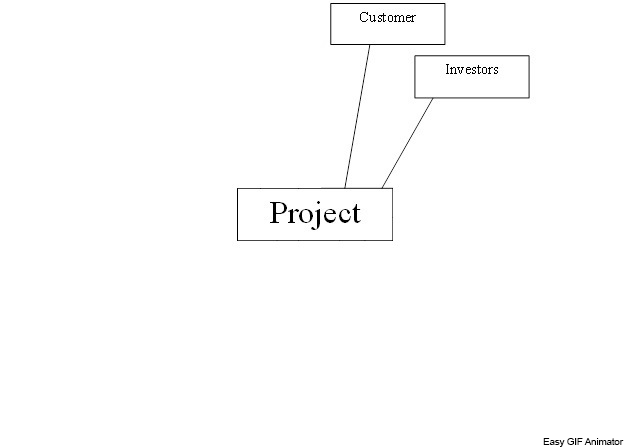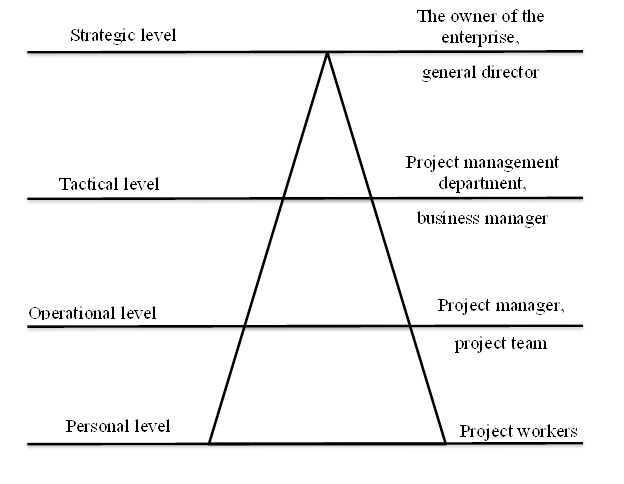Abstract on the theme of graduation work
Content
- Introduction
- 1. The purpose and objectives of the study, expected results
- 2. The theoretical basis for the implementation of draft decisions. The essence and basic provisions
- 3. Features of the formation of project management of enterprise potential. Implementation of design solutions for marketing potential management
- Conclusions
- List of sources
Introduction
The project is a temporary enterprise aimed at creating a unique product, service, result. The project is a system of strategic and tactical tasks and guidelines, as well as programs to achieve them, documented, which include interrelated finances, timelines and executors, but to a sufficient degree of independence, organization, financing, research, construction, and marketing activities aimed at to develop a specific product.
The project is a deliberate change in the constituent elements of a part of the socio-economic system. Each project should have a clear description of the expected result, the applied methodology and the estimated timelines for the work.
1. The purpose and objectives of the study, expected results
The aim of the study is the in-depth development of theoretical knowledge on project management.
The main objectives of the study:
- Systematization, consolidation, deepening and expansion of acquired knowledge, skills on the topic of research;
- Mastering the skills of independent work with special literature;
- Acquaintance with the basic conceptual concepts and methodological approaches that are used in the international practice of project management.
Research object : project management process.
Subject of research : methods and tools for planning and monitoring the implementation of a comprehensive system model of the project.
2. The theoretical basis for the implementation of draft decisions. The essence and basic provisions
A project is a set of actions whose purpose is to achieve a certain result, unique in its characteristics and features, carried out at a predetermined time, within the limit of the necessary resources (financial, human, material, etc.). The project is a system of strategic and tactical tasks and guidelines, as well as programs to achieve them, documented, which include interrelated finances, timelines and executors, but to a sufficient degree of independence, organization, financing, research, construction, and marketing activities aimed at to develop a specific product [1].
Project management should be understood as an organizational set of work aimed at solving a specific problem or achieving a specific goal, the implementation of which is limited in time, and is also associated with the consumption of financial, material and labor resources [2]. Therefore, project management is the application of knowledge, methods, skills, tools and technologies to the project, in the conditions of existing material and intangible resources of the enterprise, in order to achieve the best results of its activities [3].
The project management methodology is the tool that helps in the most efficient way to get a unique product with given restrictions (time, cost, quality). Most organizations that are not proponents of project management in the past now accept project management as the most effective means of not only surviving, but also developing in difficult market conditions.
The project includes a set of works on the implementation of processes according to its life cycle in order to create a specific product. One form of project is research projects. When creating a management system for such projects, a series of complex specific issues will have to be addressed, for example, the solution of problems of managing projects and functional units.
An important aspect of project activity is the selection of projects that are characterized by [4]:
- high uncertainty of the results;
- great process dynamism;
- the length of the period from research to receipt of the goods and bringing it to the consumer;
- high risk of achieving commercial success;
- large amounts of investment;
- high return on success;
- cyclical processes [5].
The main functions of project management, which are defined by the American Institute of Project Management, which are aimed at managing goals are: volume management, quality management, cost management, time management.
Additional functions that are aimed at managing certain objects are: personnel or human resources management, communications or information communications management, contract and project management, risk management, integration management [6].
The project has a number of inherent features only, the presence of which will help to implement its effective implementation. Key features of the project:
- changing the state of the project to achieve its goal;
- limited time;
- limited resources;
- originality.
The need for project management, namely the need to coordinate the use of human and material resources throughout the project life cycle using modern management methods and techniques to achieve an appropriate level of income for project participants, high product quality, associated with the massive increase in the scale and complexity of projects, requirements for their timing implementation, quality of work performed [7].
So, the project manager needs to ensure the best quality of the necessary work with a minimum budget and in a short time, by uniting the project participants (fig. 1).

Figure 1 – Project participants
(анимация: 7 кадров, 8 циклов повторения, 165 килобайт)
3. Features of the formation of project management of enterprise potential. Implementation of design solutions for marketing potential management
A project differs from a production system in that it is a one-time rather than a cyclical activity. Project management is carried out through a certain number of stages or phases, the transfer through which requires a certain more advanced management methodology [8].
Project management must ensure the definition of the project goal, the project structure, the amount and sources of financing, the selection of project executors, the conclusion of contracts, the timing of the project, the schedule for its implementation, the calculation of the estimate and budget, plan and take into account the risks and ensure control over the project [9].
Projects that have value for both the external and internal environment are projects whose product can be operated by consumers in the organization, and by external consumers. For example, a project to introduce a knowledge management system. When it comes to projects with ultimate value only for the outside, we mean that the project product is specially designed and created for external consumers. For example, a project to create and market a new car model.
For all projects implemented in organizations, the only thing is that there is a limited number of levels at which appropriate design decisions are made (fig. 2).

Figure 2 – Levels of design decisions and compliance with decision makers
As can be seen from the figure, at the top level, the owner or head of the organization makes strategic decisions, the impact of which extends to the entire organization as a whole. For example, a decision to diversify an enterprise.
If the organization has a project management office (a certain structure, the activity of which is aimed at building, systematizing and developing project activities in the company), which is headed by a certain person, and the leaders of individual business units that are part of the organization’s structure, then the tactical level decision is made by these people . For example, which of the resources needed to complete the project should be attracted.
The operational level is decisions made by the project manager and his team. For example, the decision to redevelop part of the project remained unchanged from the project’s target limitations.
A personal level solution is a decision of the project specialists of narrow specialists who know the technology for performing a separate work [10].
When solving the problems of planning and project management recently used the basics of systems theory and system analysis. That is, the project is considered as an open system of interconnected elements (or indicators) that have input and output parameters.
Conclusions
So, project management as a subject of study is only gaining development. There are many reasons that hinder its development and implementation in all areas of our present: unstable political situation in the state, unstable economic system, low investment, decline in production. But still there is great potential and all the necessary resources for its implementation.
It should be noted that in order to improve project management at the enterprise, to obtain opportunities to attract additional investments, it is necessary to constantly evaluate the potential, as well as to purposefully and timely manage it. However, as the study showed, in modern scientific literature, the topic of project management is one of the most ambiguous.
In this regard, another very important question arises is the need to develop a project management methodology that, for the purpose of project activities, will quickly determine the most favorable opportunities for the internal and external environment, evaluate the resources and abilities for their use, and also discover the reserves for the development of enterprise departments.
When writing this essay, the master's work is not yet completed. Final completion: June 2020. Full text of the work and materials on the topic can be obtained from the author or his manager after that date.
List of sources
- Андреева, Т. Е. Проектный менеджмент как способ достижения цели предприятия / Т. Е. Андреева, Т. Е. Петровская, Т. С Титар // Вестник экономики транспорта и промышленности. – 2011. – № 34. – С. 364–369.
- Мосалёв, А. И. Проекты в стратегической структуре соцИально-экономических систем / А. И. Мосалёв // Современная экономика: проблемы, тенденции, перспективы. 2012. URL: https://cyberleninka.ru/article/n/proekty-v-strategicheskoy-strukture-sotsialno-ekonomicheskih-sistem (дата обращения: 2.05.2019).
- Данченко, О. Б. Обзор методов анализа рисков в проектах / О. Б. Данченко, В. О. Занора // Управление проектами и развитие производства. – 2013 – №1(21). – С. 57–64.
- Молоканова, В. М. Модель жизненного цикла как основа проектного управления / В. М. Молоканова // Управление проектами и развитие производства. – 2013. – № 3 (31). – С. 30–37.
- Бушуев, С. Д. Формирование ценности в деятельности проектно-ориентированных организаций / С. Д. Бушуев, Н. С. Бушуева // Управление проектами и развитие производства. – 2013. – № 3(31). – С. 5–14.
- Можировская, З. Г. Анализ эффективности инвестиционных проектов в условиях риска / З. Г. Можировская // Сборник научно-технических работ. – 2013. – №23(14). – С. 318–321.
- Омельяненко, В. А. Анализ особенностей проектного управления инновационным развитием образования в контексте современных вызовам / В. А. Омельяненко, А. В. Желудь // Физико-математическое образование: научный журнал. – 2017. – №4(14). – С. 250–255.
- Стальная, В. А. Индустрия развлечений в мировой экономике: современные тенденции и перспективы развития / В. А. Стальная // Российский внешнеэкономический вестник. – 2009. – № 2. – С. 17–24.
- Толпежников, P. A. Маркетинговий потенціал i процеси формування конкурентних переваг / P. A. Толпежников // Вісник приазовського державного технічного університету. – 2007. – № 17. – С. 243–247.
- Дорош, М. С. Определение взаимодействия параметров системы управления проектами / М. С. Дорош, И. В. Калинько // Управление проектами и развитие производства. – 2017 – №2(22). – С. 9–16.
